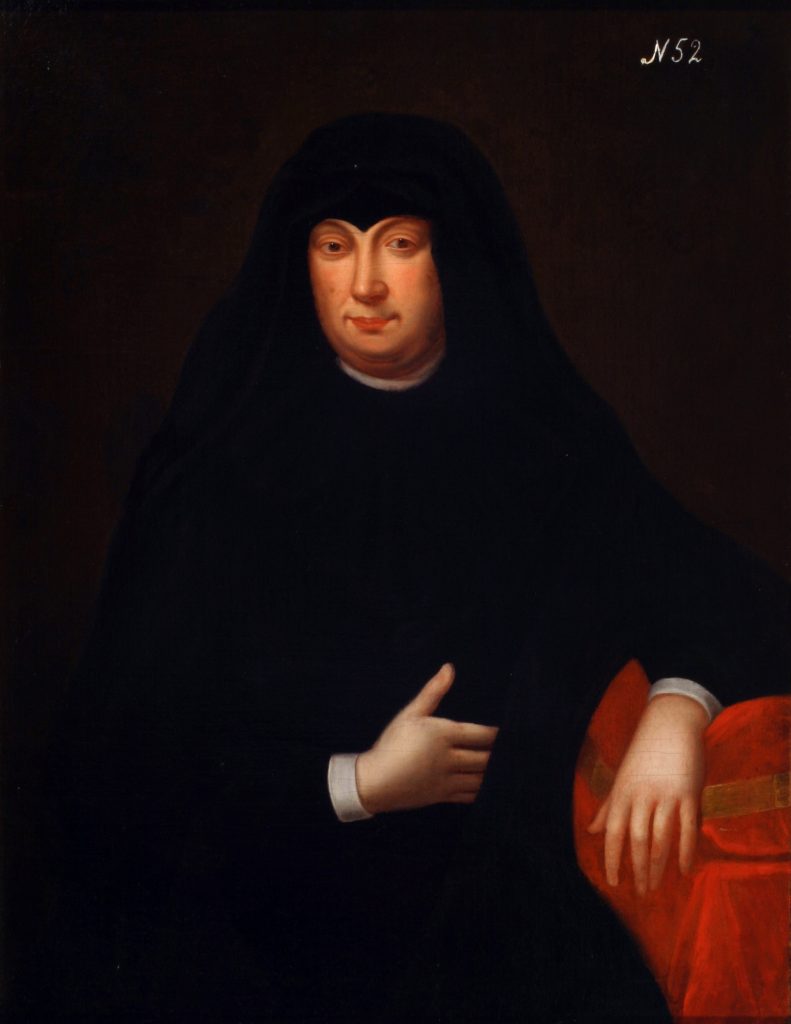Radziwiłłowa Anna Katarzyna, née Sanguszko

Anna Katarzyna Radziwiłłowa, née Sanguszko
Parents: Hieronim Sanguszko and Konstancja Sapieha,
Husband: Karol Stanisław Radziwiłł (d. 1719)
Children:
sons:
- Mikołaj Krzysztof,
- Mikołaj Kazimierz,
- Hieronim Florian
daughters:
- Tekla Róża (wife of Jakub Flemming, Michał Serwacy Wiśniowiecki and Michał Antoni Sapieha),
- Katarzyna Barbara (wife of Jan Klemens Branicki),
- Konstancja Franciszka (wife of Jan Fryderyk Sapieha),
- Karolina Teresa (wife of Kazimierz Leon Sapieha, and then Józef Aleksander Jabłonowski)
was widowed in 1719 and from then on she was actively involved in the politics of the Radziwiłł family, becoming the main author of its political and economic activities, as well as the initiator of the matrimonial policy involving her children. She spared no effort to take advantage of the opportunities to create the family’s public, as well as private, image. She took her role in the process all the more seriously, because after the death of her husband, Karol Stanisław Radziwiłł (died 1719), she felt responsible for the further fate of the family and its image in society. Thus, in her widowhood, she became the actual author of the Radziwiłł family policy. As an extremely enterprising and ambitious person, perfectly versed in the realities of political and social circles, she efficiently managed the actions of her closest relatives. Her main goal was to save the position of the Radziwiłł family, which was weakening in the 18th century. She was actively involved in arranging marriages for her children, finding ways to restore the power of the house of Radziwiłł. She died in 1746.
The Court:
According to previous findings, her court numbered 347 people. Her main seat was in Biała (modern Biała Podlaska), where she received guests and from where she managed the Radziwiłł estate. On the basis of the preserved records of expenditures, it is possible to distinguish various groups of people who served at the court. Most of them remain anonymous – in the source material, people responsible for various activities are described only by their profession. Only a few of those working for Anna Katarzyna were always named. Among those serving at Radziwiłłowa’s court, the most frequently mentioned were Wiśniowski and Korypski – responsible for supervising the property, cashier Szmujło Ickowicz, Siedlarzewski, architects von Berg, Goffaux, and Deshomme, Tomasz Mogilnicki – the duchess’s trusted representative, Łukaszewicz – a caretaker, a married couple by the name of Wiśnicki, Otto – the treasurer, Florek – a doctor, Żubowicz – the Duchess’s commissioner, Buharewicz – administrator of the Biała estate, Machnicki – secretary. Several secretaries were also employed to oversee financial affairs. Particularly noteworthy is the group of servants closest to the duchess. At the court of Anna Katarzyna Radziwiłłowa, née Sanguszko, this group included, among others, pages. There were also at least a few butlers serving at her court. In addition, people of various professions were employed, responsible for the day-to-day functioning of the household. Among the servants we can also distinguish people pursuing specific artistic endeavours. Several painters and draughtsmen were employed at the court, as well as a goldsmith, who decorated, among others, the duchess’s clocks. The dwarfs residing at the court should be put in a separate category. It is difficult to classify them as typical servants – they were merely an attraction for the duchess’s inner circle. Furthermore, individual mentions confirm that black servants were also employed at the court. As in the case of dwarfs, it is difficult to assign them to a group performing specific functions or professions. Their presence was rather a manifestation of the influence of European fashion, willingly adopted at magnates’ courts.
See also:
Penkała-Jastrzębska A. Publiczne awantury i prywatne interesy : Anna Katarzyna z Sanguszków Radziwiłłowa a sprawy wewnętrzne Rzeczypospolitej w dobie wojny o polską sukcesję (1733-1735), Przegląd Historyczny, 2022, T. 113, z. 2, s. 255-284 LINK
Penkała-Jastrzębska A., Świat kultury materialnej na magnackim dworze na przykładzie rejestrów majątkowych Anny Katarzyny z Sanguszków Radziwiłłowej z lat 1738-1741, „Kwartalnik Historii Kultury Materialnej” 2021, R. 69, nr 1, s. 101-120 LINK
Penkała-Jastrzębska A., Służba na kobiecym dworze magnackim. Przyczynek do analizy zagadnienia w świetle rejestrów dworskich Anny Katarzyny z Sanguszków Radziwiłłowej [w:] Dwór kobiecy w Rzeczypospolitej XVII i XVIII, red. B. Popiołek, A. Penkała-Jastrzębska, K. Pyzel, Kraków 2021 LINK
Penkała- Jastrzębska A., W kręgu Anny z Sanguszków Radziwiłłowej : rola uroczystości prywatnych w polityce kreowania wizerunku rodziny Radziwiłłów [w:] Wokół Sobieskich i Radziwiłłów : prestiż, przejawy pobożności, działalność polityczna, red. Jarosław Pietrzak, Nieborów 2020, s. 112-121 LINK
Penkała- Jastrzębska A., Problematyczne konkury : nieznane okoliczności starań Michała Kazimierza Radziwiłła (1702-1762) o rękę Marii Zofii Sieniawskiej (1699-1771) „Klio” 2019, Vol. 51, nr 4, s. 85-108 LINK
Penkała-Jastrzębska A., Radości i troski osiemnastowiecznego macierzyństwa w świetle korespondencji Karoliny Teresy z Radziwiłłów Jabłonowskiej do matki Anny z Sanguszków Radziwiłłowej, „Horyzonty Wychowania”, nr 18/46, 2019, s. 69-82 LINK
Karkucińska W., Anna z Sanguszków Radziwiłłowa (1676-1746). Działalność gospodarcza i mecenat, Warszawa 2000
Kondratiuk T., Mecenat Anny z Sanguszków Radziwiłłowej: (1676-1746), Biała Podlaska 1986; Z. Przyrembel, Farfurnie polskie dawne i dzisiejsze, Lwów 1936, s. 42-43.
 Women's noble court in the Polish-Lithuanian Commonwealth in the Saxon times. Structure, people, culture, functions
Women's noble court in the Polish-Lithuanian Commonwealth in the Saxon times. Structure, people, culture, functions
